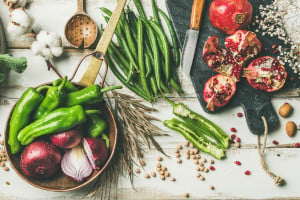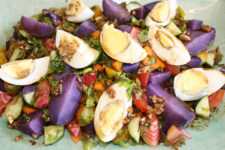This one-pan breakfast is the perfect dish to start your weekend! With a variety of vegetables and fresh herbs, this meal is chock full of flavor and the perfect size for feeding the whole family.

Sauteed bell pepper, zucchini, broccoli, and garlic mix perfectly with chives, parsley, and dill to elevate your standard egg breakfast into something extraordinary. Mix in the eggs and pop the pan in the oven for a fluffy, flavorful meal that’s ready in less than 30 minutes.
Hearty enough to serve alone, this frittata only gets better when served alongside Summer Blueberry and Nectarine Scones or Sweet Potato Cinnamon Rolls.
Why You’ll Love This Recipe
- Easily customizable. You can easily switch out vegetables or add your favorite herbs to fit your taste and the fresh fare you have on hand.
- A great way to use up your backyard harvest. All the fresh veggies in this recipe make it a wonderful way to use up extra produce from your vegetable garden, especially those fresh herbs.
- Easy clean-up. You only need to get out one pan to make this easy breakfast, just make sure it’s ovenproof!
- Make-ahead friendly. You can easily saute the vegetables and prepare the egg mixture the night before to shorten the cooking time the next morning.

What Is a Frittata?
The word frittata is derived from the Italian word friggere, which means fried. Originally used to describe any egg dish that contained fried eggs, “frittata” is now used specifically to reference an open-face, Italian-style omelet.
Frittatas differ from traditional omelets in a few key ways.
For one, the vegetables, meat, and/or cheese ingredients are mixed into the raw egg mixture rather than layered on top of the eggs. This mixture is cooked in the pan until the bottom sets. But instead of folding the eggs to cook the inside, the eggs are left flat and the entire pan is placed in the oven.
Often, the egg mixture for the frittata is beaten vigorously to increase the amount of air bubbles inside. This helps give the final product a fluffy, airy texture.

How to Make a Garden Veggie Frittata
This hearty frittata has a long list of ingredients, but they come together fairly quickly in just a few easy steps. Let’s take a quick look at how to make this amazing frittata.
Key Ingredients
- Eggs. You may not realize it, but the flavor of eggs can vary dramatically based on the diet of the chickens that lay them. I recommend opting for free-range eggs for this recipe. These tend to have a deeper orange color and richer flavor thanks to the varied, protein-rich diet of the hens.
- Garlic. This fresh ingredient brings a ton of intense flavor to the dish. If you’re a big garlic fan, don’t be afraid to add more!
- Mozzarella cheese. I use mozzarella in this recipe because the mild flavor mixes well with the bolder flavor of the herbs. But feel free to mix it up and try feta, parmesan cheese, or another delicious Mediterranean cheese. Or go with the old standby and use cheddar cheese.
- Herbs. Fresh herbs are key to really making this recipe pop. If you don’t have parsley, dill, and chives on hand, feel free to substitute other fresh herbs in their place.
Step-by-Step Instructions

Step 1: Sauté the vegetables. Put the cast iron skillet on medium-high heat and stir frequently until the veggies are soft.

Step 2: Make the egg mixture. Add eggs, herbs, and cheese and mix well.

Step 3: Bake the frittata in the oven. Pour the egg mixture into the skillet with the vegetables and place the skillet in the oven until the middle has set.

Recipe Tips and Variations
- Stir the eggs vigorously. The more air you can inject into the eggs while beating them and mixing in the herbs, the fluffier the final product will be.
- Substitute vegetables as needed. The mix of vegetables I chose goes well together, but there is always room to mix it up. Mushrooms, yellow squash, spinach, asparagus, and red onion are some other great options to try.
- If you want crispier edges, try flipping the frittata and finishing it on the stovetop. This takes a lot of extra skill, but it provides a whole new texture experience.
- Make it an egg-white frittata. By swapping out the 6 whole eggs with 12 egg whites, you can make this a low-fat breakfast.
Make-Ahead & Storage Recommendations
This recipe can easily be made ahead of time. Simply saute the vegetables and mix them in with the egg, herb, and cheese mixture. Cover the mix and place in the fridge until ready to bake.
The mixture will keep for up to two days.
NOTE: If making ahead, wait to add the salt until right before you bake the mixture.
Leftover frittata should be placed in an airtight container and put in the fridge. You can reheat it in the microwave or oven. Using the baking function on an air fryer also works very well.
Frittata does not reheat well after being frozen, so I do not recommend freezing leftovers.
Frequently Asked Questions
Why is my frittata watery?
Frittatas can become watery if the egg mixture is left to sit too long before baking. This is especially true if salt is added. For better results, add salt and mix well right before the mix goes into a preheated oven.
How do you know when a frittata is done?
When fully cooked, the center of the frittata should be firm to the touch and not jiggly. You should be able to cut through the center and bring out a clean knife. Once the edges begin to brown, the frittata is overdone.
Does a frittata need to rest?
It is good to let a frittata rest for about five minutes after it comes out of the oven. Often, the crust will begin to brown before the middle is cooked. By pulling it out before the edges brown and letting it sit, the middle has time to finish cooking thanks to the residual heat left in the pan.

Serving Suggestions
There are plenty of great ways to dress up your frittata as well as some wonderful options for side dishes that go well with this savory dish. Here are some of my favorite serving suggestions:
- Homemade Sriracha Sauce – Adds a spicy twist.
- Green Tomato Chutney – Savory and sour.
- Garlic Chili Sauce – For the garlic lovers who like a little spice.
- Healthy Banana Pancakes – The perfect side to satisfy that sweet tooth!
- Smoothie Bowls – 18 recipes to try.
- Chia Jam – Fruity and energizing.
- Peanut Butter Chocolate Smoothie – A little breakfast treat to help wash down that frittata.
Garden Veggie Frittata
Equipment
- oven-safe skillet
- mixing bowl
- whisk
Ingredients
- 1 tbsp. olive oil
- ½ red bell pepper sliced
- ½ green bell pepper sliced
- ½ cup zucchini sliced
- 1 cup broccoli florets sliced
- ½ tsp. garlic minced
- ½ cup Mozzarella cheese
- ¼ cup fresh parsley finely chopped
- ¼ cup fresh dill finely chopped
- ¼ cup chives finely chopped
- 8 eggs
- salt and pepper
Instructions
- Preheat the oven to 350ºF.
- Heat an iron skillet to medium-high and add the olive oil.
- Add the red bell pepper, green bell pepper, zucchini, garlic, and broccoli. Cook the veggies for about 7 minutes or until they start to get soft.
- Break the eggs in a large bowl and add the mozzarella cheese, fresh herbs, veggies, salt, and pepper and combine well.
- Return the mixture to the iron skillet, then bake for 15-20 minutes, or until it’s set in the middle.







